#Sarah Cascone
Text




“Radiant Memories” (2020) James Little’s vibrant laminated glass artwork at LIRR Jamaica station, incorporates layers of colorful, intricate lines that together form flat, gradated blocks of color, creating a sense of movement and animation as the light shifts throughout the day. MTA Arts’ largest MTA LIRR installation to date brings a fresh aesthetic to the station and provides an immediate wayfinding signal to Brooklyn-bound commuters as they navigate their transfers.
James Little’s solo exhibition “Black Stars & White Paintings” is currently on view at Kavi Gupta in Chicago. In a recent studio visit, the artist told @artnet ’s Sarah Cascone: “In order to achieve simplicity, you have to understand a lot of complexities. My Black and White paintings both play with this idea – geometry and color each serve a very distinct purpose and, when integrated just right, you know it’s working.” Read the full article “See Inside James Little’s Studio, Where He Combines Pigment, Beeswax, and Varnish to Create Layered Geometric Abstractions” on Artnet News.
Photos: Sophia Little
24 notes
·
View notes
Photo

Sarah Cascone Gallery Visitor Onboard Red Grooms’ “The Bus” 1995
106 notes
·
View notes
Photo
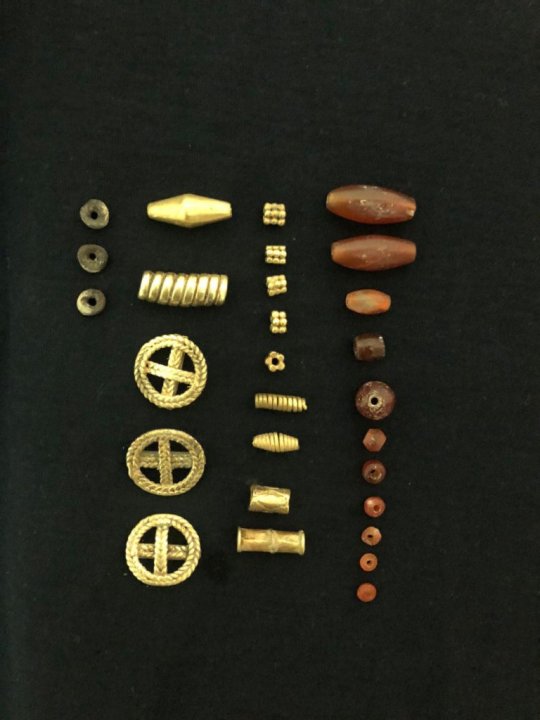


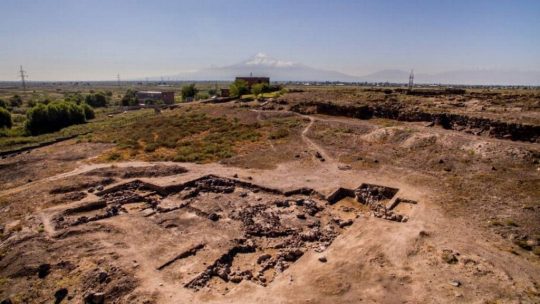
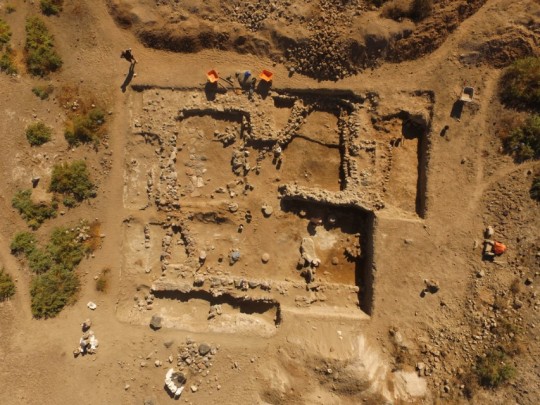




Archaeologists in Armenia Discover an Ancient ‘Golden Tomb’
It's the latest find from a joint Polish and Armenian excavation effort begun in 2013.
Archaeologists at Metsamor, an ancient necropolis in Armenia, have discovered a tomb filled with gold pendants and more than a hundred amber and carnelian beads. Dating to the late Bronze Age (1,300 to 1,200 B.C.E.), the grave also held the remains of a man and a woman, who appear to have be buried at the same time.
“Their death is a mystery to us, we do not know the cause, but everything indicates that they died at the same time, because there are no traces of tomb reopening,” Krzysztof Jakubiak, an archaeology professor at the University of Warsaw, said in a statement.
Laid to rest in an eternal embrace, the couple was buried in a cist, a stone-lined chamber dug into the ground. Believed to have died in their 30s, one wore bronze bracelets, the other a tin wire ring.
The grave also included a wooden burial bed, a faience flask, and about a dozen ceramic vessels. According to researchers, the beads and pendants were originally part of three necklaces, and the flask would have been imported from the Syrian-Mesopotamian borderland.
The research project at the Ararack Valley is a joint effort the Polish Center of Mediterranean Archaeology at the University of Warsaw and Armenia’s Service for the Protection of Historical Environment and Cultural Museum-Reserves, led by Jakubiak and Ashot Piliposian. The partnership has been ongoing since 2013, according to the Greek publication Archaeology; an exhibition of their findings opened last fall at the Armenian History Museum in nearby Yerevan.
To date, archaeologists have discovered about 100 graves in the cemetery, but the newly found golden tomb is one of the few that were not looted prior to the start of excavations in 1965. The cist graves would have been covered with burial mounds of earth that have eroded over the centuries.
Because the ancient Armenians do not appear to have been illiterate, and left behind no written records, archaeologists know little about Metsamor society. The walled settlement was at its height from 4th to the 2nd millennium B.C.E., with temple complexes surrounding a central fortress.
“It was a very large settlement. Even fortifications made of huge stone blocks have survived to our times, encircling the so-called citadel on the hill,” Jakubiak said. “There was no other settlement in the region that could be compared in terms of importance and size.”
By Sarah Cascone.
#Archaeologists in Armenia Discover an Ancient ‘Golden Tomb’#Metsamor#ancient tomn#ancient grave#ancient necropolis#ancient artifacts#archeology#archeolgst#gold#gold jewelry#history#history news#ancient history#ancient culture#ancient civilizations#bronze age
51 notes
·
View notes
Text

Emily Sargent (USA, 1857 - 1929) copying an Old Master painting at the National Gallery, London (ca. 1930). Photo courtesy of R.Ormond.

Emily Sargent, Untitled (Tropical Seascape). Collection of the Sargent House Museum.
Read: Emily Sargent, Not Just a Sister to John, Was a Serious Painter in Her Own Right. Her Watercolor Landscapes are Finally Entering Museums—and the Spotlight
John Singer Sargent's family has donated never-before-seen work by Emily to seven museums.
Sarah Cascone | February 6, 2023
8 notes
·
View notes
Text

Chance Encounters #007
Gordon Mumma, Vladislav Delay & Eyvind Aarset, Ben Frost, Alial Straa, Charles Olsen, Graham Lambkin & Áine O’Dwyer, Félicia Atkinson, Feronia Wennborg, Yama Yuki, Permanent Six Flags, Sarah Davarchi & Sean McCann, Angus Carlyle, Pierre Schaeffer & Pierre Henry, Charlie Morrow, AGF & Delay, Valentina Magaletti & Laila Sakimi, Geneva Skeet, Merzbow, Mats Gustafsson & Balazs Pandi, LFO, Michiko Hirayama, Eliane Radigue, Stephen Vitiello, Cia Rinne & Sebastian Eskilden, Felicity Mangan, Kim Cascone, Roméo Poirier, Francisco Lopez, Ganavya, Caroline Shaw & Attacca Quartet, The Australian Art Orchestra, Clara de Asis & Ryoko Akama, Paul Beaudoin
4 notes
·
View notes
Photo





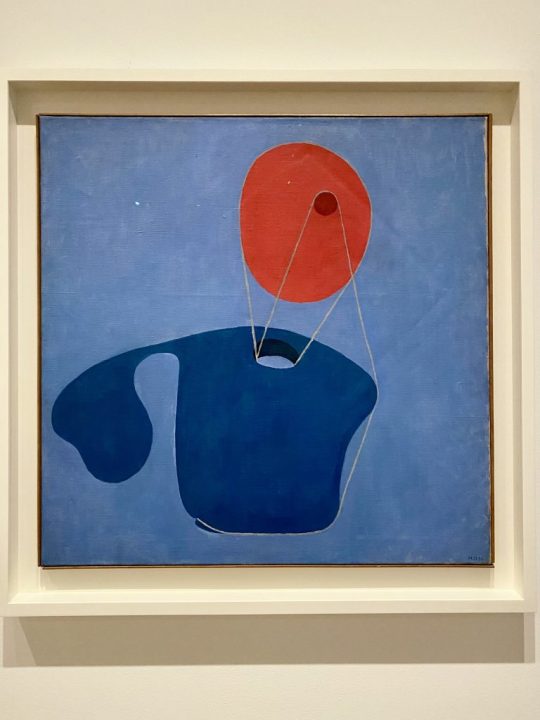


Inside Meret Oppenheim's 'Otherworldly, Witty, Whimsical' Show at MoMA, the Swiss Surrealist's First U.S. Museum Retrospective in a Generation | Artnet News
Meret Oppenheim, 1982. Photo by Harry Croner.
Meret Oppenheim, Object (Objet [Le Déjeuner en Fourrure]) (1936). Photo courtesy of the Museum of Modern Art, New York.
Meret Oppenheim, Pair of Gloves (1985). Collection of the Kunstmuseum Bern, gift of Ruth von Büren. Courtesy of the Museum of Modern Art.
Meret Oppenheim, X-Ray of M.O.’s Skull (Röntgenaufnahme des Schädels M.O.), 1964/1981. Hermann and Margrit Rupf Foundation. Kunstmuseum Bern. Photo courtesy of the Museum of Modern Art, New York.
Installation view of “Meret Oppenheim: My Exhibition” on view at the Museum of Modern Art, New York. Her sculpture The Green Spectator (1959) blocks a doorway between galleries, a design choice envisioned by the artist in set of 1983 drawings for a possible retrospective of her work. Photo by Jonathan Muzikar, courtesy of the Museum of Modern Art, New York.
Meret Oppenheim, Red Head, Blue Body (1936). Collection of the Museum of Modern Art, New York, Meret Oppenheim Bequest. Photo by Sarah Cascone.
Meret Oppenheim, Stone Woman (1938). Photo by Sarah Cascone.
Meret Oppenheim, Ma Gouvernante (My Nurse), 1936. Collection of the Moderna Museet, Stockholm. Photo by Sarah Cascone.
If you know the name Meret Oppenheim, you probably associate the artist with one thing: fur. A new exhibition at the Museum of Modern Art, however, proves the Surrealist to be an artist of endless creativity and incredible versatility who drew, painted, and sculpted in a wide range of media and materials.
“She just had a remarkable imagination and unrivaled ability to get up in the morning and never do the same thing twice,” Anne Umland, the museum’s senior curator of painting and sculpture, told Artnet News. “It’s pretty radical that throughout her five-decade career, she managed to remain committed to a very otherworldly, witty, whimsical sensibility.”
The show, titled “Meret Oppenheim: My Exhibition,” is the artist’s first U.S. exhibition in 25 years, and it features numerous pieces that are being shown in the country for the first time. It originated at Switzerland’s Kunstmuseum Bern, which has the world’s largest holdings of the artist’s work, and is co-organized by the two museums and Houston’s Menil Collection. ...
26 notes
·
View notes
Text
The discovery of an impressive Greek tunnel under an ancient Egyptian temple (which perhaps is related to the tomb of Cleopatra)
I reblog this article about the discovery of an impressive tunnel of Greek style and engineering under an ancient Egyptian temple of the Hellenistic period. I don’t know whether it is really related to the tomb of Cleopatra VII Philopator, last Egyptian Pharaoh and Greek queen of Egypt. The future will show if the the expectations of the archaeologists who have done the excavation are founded or not, although I think that the discovery of the tunnel does not mean anything directly about the location of the tomb of the queen. But this discovery is itself very important, independently of the question of the tomb of Cleopatra. Moreover, the truth is that I would like to learn more about the function of this tunnel and its relation to the temple of Tapuziris Magna, questions which are also very important.
“An Ancient Tunnel Discovered Beneath an Egyptian Temple May Lead to Cleopatra’s Tomb, Archaeologists Say
For nearly 20 years, archaeologists have been searching the area around the temple Tapuziris Magna for the final resting place of the Egyptian queen and her husband Mark Antony.
Sarah Cascone, November 7, 2022

An alabaster statue of Cleopatra is shown to the press at the temple of Tasposiris Magna on the outskirts of Alexandria, on April 19, 2009. Archaeologists are now more convinced than ever that the tomb of Marc Anthony and Cleopatra lies nearby. Photo credit should read Cris Bouroncle/AFP via Getty Images.
Archaeologists have discovered a rock-cut tunnel beneath Egypt’s ancient Taposiris Magna Temple—and it may lead to the lost tomb of Cleopatra, who was the last ruler of Ptolemaic Egypt from 51 to 30 B.C.E.
The Egyptian Ministry of Tourism and Antiquities announced the find last week, describing the 4,265-foot tunnel, located 43 feet underground, as a “geometric miracle.” It is similar to the Tunnel of Eupalinos on the Greek Island of Samos, considered one antiquity’s engineering marvels.
News of the discovery, made during an excavation project led by archaeologist Kathleen Martinez of the University of San Domingo, was reported by Ancient Origins.
Cleopatra famously died by suicide after her husband, the Roman general Mark Antony, also killed himself. The two are believed to have been buried together.

The Greco-Roman tunnel archaeologists discovered beneath Tapuziris Magna Temple near Alexandria could be a sign that the lost tomb of Cleopatra and Mark Antony lies nearby. Photo courtesy of the Egyptian Ministry of Tourism.
Martinez first came to Egypt in search of Cleopatra’s tomb some 20 years ago, convinced after more than a decade of research that Taposiris Magna, located on outskirts of Alexandria and dedicated to Osiris, the god of the dead, was a leading candidate for the queen’s burial spot.
After hundreds of ignored emails, Martinez managed to secure a meeting in Cairo with archaeologist Zahi Hawass, then the country’s minister of Egypt’s antiquities affairs.
She convinced him to give her two months to conduct excavations on the site. Work has been ongoing since 2004—but the new find is the most compelling evidence to date that Martinez is on the right track.

Archaeologists discovered this alabaster head at excavations beneath Tapuziris Magna Temple near Alexandria. Photo courtesy of the Egyptian Ministry of Tourism.
“This is the perfect place for the tomb of Cleopatra,” Martinez told the blog Heritage Key. “If there’s a one percent chance that the last queen of Egypt could be buried there, it is my duty to search for her. If we discover the tomb… it will be the most important discovery of the 21st century. If we do not discover the tomb… we made major discoveries here, inside the temple and outside the temple.”
To date, the excavations have revealed mummies with golden tongues and a cemetery containing Greco-Roman-style mummies buried facing the temple, which supports Martinez’s theory that a royal tomb was built in the area. There was also a bust believed to depict Cleopatra and 22 coins depicting her visage.
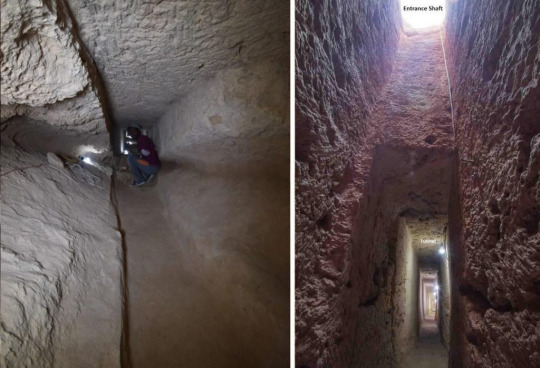
The Greco-Roman tunnel archaeologists discovered beneath Tapuziris Magna Temple near Alexandria could be a sign that the lost tomb of Cleopatra and Mark Antony lies nearby. Photo courtesy of the Egyptian Ministry of Tourism.
In addition to the tunnel, the latest find includes two Ptolemaic-era alabaster statues, one of which appears to be a sphinx, as well as ceramic vessels and pots. Part of the tunnel is underwater, perhaps due to ancient earthquakes that struck the region between 320 and 1303 C.E. Those natural disasters could have led to the collapse of the Taposiris Magna.
Egypt’s most famed archaeological discovery, of course, is King Tut’s tomb, unearthed 100 years ago last week by Howard Carter in the Valley of Kings outside the city of Luxor.
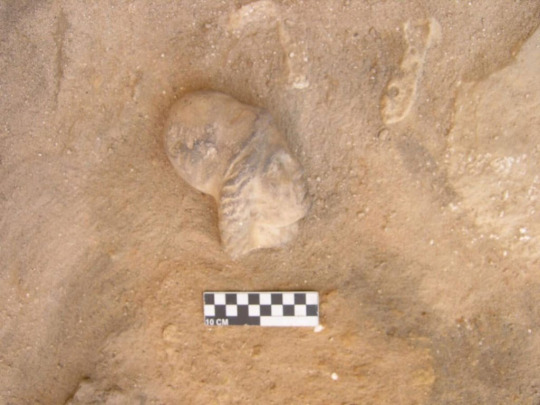
Archaeologists discovered this alabaster head at excavations beneath Tapuziris Magna Temple near Alexandria. Photo courtesy of the Egyptian Ministry of Tourism.
A century later, the site is still the subject of active, fruitful excavations—and debate, with scholars and experts divided on the possibility that the burial chamber contains hidden rooms.
British Egyptologist Nicholas Reeves has been a longstanding proponent of the theory that it was originally built as the tomb of Nefertiti, the boy king’s stepmother. (Hawass has separately claimed that he is on the verge of announcing the discovery of Nefertiti’s resting place.)
Source: https://news.artnet.com/art-world/archaeologists-tunnel-cleopatra-tomb-2205456

Kathleen Teresa Martínez Berry (born 1966) is a Dominican lawyer, archaeologist, and diplomat, best known for her work since 2005 in the search for the tomb of Cleopatra in the Taposiris Magna temple in Egypt. She heads the Egyptian-Dominican mission in Alexandria, and is currently minister counselor in charge of cultural affairs at the Dominican embassy in Egypt. Source: https://en.wikipedia.org/wiki/Kathleen_Mart%C3%ADnez
19 notes
·
View notes
Text
(news.artnet.com/art-world/gender-discrimination-art-study-2171375)
In a Series of Behavioral Experiments, Viewers Preferred Works by Women Artists—But Assumed Works by Men Were More Famous and Valuable
Sarah Cascone, September 7, 2022
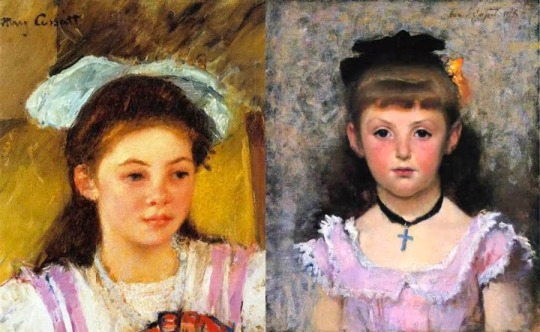
Mary Cassatt, Ellen Mary Cassatt with a large bow in her hair (1909). Private collection. John Singer Sargent, Portrait of Jeanne Kieffer (1879). Private collection.
Does gender bias affect our opinions about work made by male and female artists? According to a new study, people aren’t more likely to prefer a work by a man than a near-identical composition by a woman—but they’ll assume that his work is more famous and worth more money.
“Gender discrimination in art comes not from personal aesthetic preference—[Georg] Baselitz’[s] argument that women ‘don’t paint very well’—but people thinking paintings are more valuable and famous when painted by male artists,” study authors Robert Hoffmann, a professor of behavioral economics at the University of Tasmania, and Bronwyn Coate, a senior lecturer in economics at the Royal Melbourne Institute of Technology, wrote in the academic journal The Conversation. (https://theconversation.com/male-artists-dominate-galleries-our-research-explored-if-its-because-women-dont-paint-very-well-or-just-discrimination-189221)
These findings are perhaps unsurprising, considering that men dominate the art market. As of 2019, women represented just 2 percent of art sales at auction. At 26 prominent American museums, they made up a mere 11 percent of acquisitions and 14 percent of exhibitions.
(https://news.artnet.com/womens-place-in-the-art-world/female-artists-represent-just-2-percent-market-heres-can-change-1654954) (https://news.artnet.com/womens-place-in-the-art-world/womens-place-art-world-museums-1654714)
Such statistics, therefore, skew our perceptions of otherwise remarkably similar works of art, causing viewers to assume that male artists are more successful and command higher prices. In other words, we assume that other people discriminate based on gender, which in turn creates more opportunity for gender discrimination in a vicious cycle.

Ambrosius Bosschaert, Flowers in a Glass Vase. Collection of the National Gallery, London. Maria van Oosterwijck, Flowers in a vase on a marble ledge (after 1680). Private collection.
Titled “Fame, What’s your name? quasi and statistical gender discrimination in an art valuation experiment,” the study appears in the upcoming issue of the Journal of Economic Behavior and Organization.
(https://www.sciencedirect.com/science/article/abs/pii/S0167268122002669?dgcid=author) (https://www.sciencedirect.com/journal/journal-of-economic-behavior-and-organization)
In each of the five experiments, a group of 1,112 average Americans were asked to examine pairs of paintings. Created between 1625 and 1979, the works were incredibly similar in style and subject matter, but one was by a man and one was by a woman.
In the first experiment, one group of participants were given only the title of the work, while in the other they also had the artist’s name, and thus could guess if the artist was male or female. In both groups, 54 percent of respondents preferred the work by women.

Eva Gonzalès, Roses in a Glass (ca. 1880–82). Gustave Caillebotte, Yellow Roses in a Vase (1882). Collection of the Dallas Museum of Art.
The result was the same in a second experiment asking participant to guess which work was more popular among those surveyed.
But in the third and fourth experiments, when asked which of the two works was more valuable and which artist was more famous, number of guesses for female paintings fell by 10 percent and 9 percent, respectively.
The final experiment compared responses from two groups, one of which was told which of the two artists was more famous—almost always the man. That group was 14 percent more likely to guess that the male artists’ work was more popular.

Lilla Cabot Perry, The Cellist. Private collection. William Merritt Chase, The Mandolin Player (1879). Private collection.
“If women artists were discriminated against just because of their gender, we would have seen a higher premium put on the male artists even in questions of aesthetics,” Hoffmann and Coate wrote. “Discrimination only occurred when our participants were asked to assign a monetary value to the art works, or when they were given information about the level of fame of the painter.”
Such assumptions perpetuate the historical advantages enjoyed by male artists, who were afforded more art education and more opportunities to exhibit and sell their work. Women, on the other hand, were often expected to stay home and raise their children, curtailing their artistic careers.
#gender bias#link#research#radblr#radfems do interact#radfems do touch#art#article#paintings#women's art#men's art#gender discrimination#misogyny#patriarchy#inequality#radfems interact#radfems touch#behavioral experiments#sex discrimination#sex bias
5 notes
·
View notes
Text
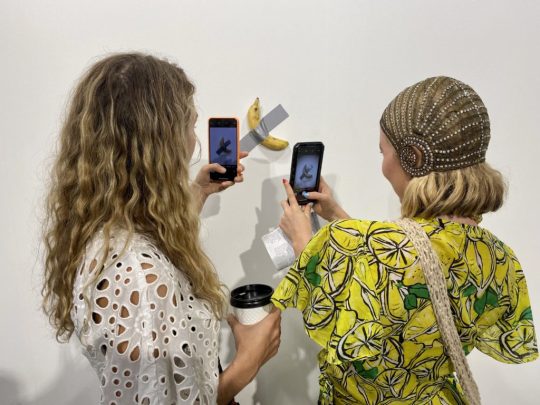
Maurizio Cattelan's Comedian, for sale from Perrotin at Art Basel Miami Beach. Photo by Sarah Cascone.
0 notes
Text
U.S. Returns $33 Million of Looted Antiquities to Turkey 🇹🇷! The Collection of 12 Items Included a Headless Bronze Statue Dating to 225 C.E.
— Teresa Nowakowski, Staff Contributor | April 7, 2023 | Smithsonian Mag

One of the 12 antiquities that U.S. authorities returned to Turkey last month Suleyman Elcin/Anadolu Agency via Getty Images
More than 50 years ago, farmers uncovered an archaeological treasure trove at Bubon, a Roman site in southwestern Turkey. The area, likely a shrine used to worship the emperor and his family, contained several rare bronze statues of Roman emperors and empresses.
“Had its contents not vanished, it would have been one of the most stunning archaeological discoveries of the 20th century,” writes Elizabeth Marlowe, director of Colgate University’s museum studies program, in Hyperallergic.
Rather than reporting the find to the government, as required by law, locals sold the statues, which were then smuggled out of the country.
“The looting back then was done as a commercial enterprise for the villagers,” Matthew Bogdanos, the head of the Manhattan district attorney’s office’s antiquities trafficking unit, tells the New York Times’ Tom Mashberg and Graham Bowley.
Now, one of these statues is heading back to Turkey: Dating to 225 C.E., the headless bronze figure had been on display at the Metropolitan Museum of Art since 2011. Experts think it depicts the Roman emperor Septimius Severus.
The work is one of a dozen artifacts repatriated to Turkey last month following investigations carried out by the Manhattan district attorney’s office. The collection also includes a sculpture of a head dating to 290 C.E., as well as a bronze head of Caracalla, the eldest son of Septimius Severus, made between 211 and 217 C.E. In total, the items are valued at $33 million.
“Many of these pieces, which come from archaeological sites that have been the persistent target of looting, have been circulating across the globe for decades,” says District Attorney Alvin L. Bragg, Jr. in a statement. “Now, they are finally being returned to Turkey, where they rightfully belong,”
Some of the farmers involved in the looting back in the ’60s are helping investigators, examining images from catalogs and museum websites to identify pieces they had stolen, reports the Times.
Of the items returning to Turkey, three came from the Met—including the Septimius Severus statue, valued at $25 million, which was seized in February. This year, the district attorney’s office has so far seized 17 items from the museum, reports Artnet’s Sarah Cascone.
Several other items were recovered during a criminal investigation into the collection of Shelby White, a philanthropist, art collector and Met trustee.
Authorities officially returned the 12 items to Turkey at a ceremony last month. Reyhan Ozgur, Turkey’s consul general in New York, said that the repatriation “sends a clear and strong message to all smugglers, dealers and collectors that illegal purchase, possession and sale of cultural artifacts will have consequences,” per the Times.
The latest repatriation is part of a growing worldwide effort to return stolen antiquities to their rightful owners. In particular, the Manhattan district attorney’s office, which launched its antiquities trafficking unit in 2017, has been intensifying its efforts to investigate these cases.
0 notes
Text
Get Your Art Fix!

“Tomorrow belongs to those who can hear it coming.” ~ David Bowie
Get Your Art Fix!
"Natural Villains (B&W)" by Markus Klinko, 2002
Series: Bowie Unseen
Arty-Fact: On the strength of [his] work for David Bowie's "Heathen" album, Markus was asked to create the cover image for GQ‘s “Man of the Year” issue honouring David. The resulting image shows the rock star fearlessly posing with a pack of wild wolves. Due to David's busy schedule and lack of availability for another shoot, Markus was forced to use a body double with the wolves, carefully adding in the singer’s face from the photos taken for "Heathen" during post-production.
“Our male model proved himself quite brave, as he worked it with the energetic and sometimes aggressive wolves. While his face looked nothing like Bowie, he was able to channel him through his body language.” ~ Markus Klinko
Source: "Markus Klinko’s Amazing Never-Before-Seen Photos of David Bowie" by Sarah Cascone, ArtNet News, 2016
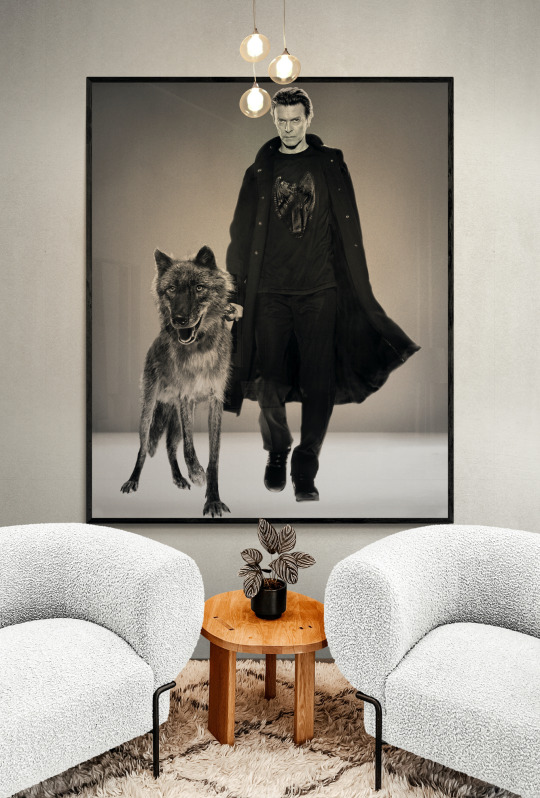
See It On your Wall
1 note
·
View note
Text
Auctions Born Without Arms or Legs, the Victorian Artist Sarah Biffin Painted Beautifully With Her Teeth. Now, She’s Become a Market Star Two years ago, Biffin's auction record was about $3,400. Now it's exploding. Sarah Cascone, December 20, 2021 A self-portrait by Sarah Biffin. Collection of the Wellcome Collection, London. A self-portrait by Sarah Biffin. Collection of the Wellcome Collection, London. A unique figure from the annals of art history has found sudden success on the auction block, with a small watercolor by Victorian miniature painter Sarah Biffin nearly doubling its high estimate of £5,000 ($6,680) to sell for £9,000 ($12,023) at Sworders Fine Art Auctioneers in the U.K. The artist, who was born without arms or legs, was a member of a traveling a circus in England, where she was billed as “The Limbless Wonder.” Born into poverty in Somerset in 1784, Biffin likely suffered from a condition called phocomelia. She nevertheless taught herself to write, paint, sew, and use scissors with her teeth. She joined the circus at age 13, where she earned £5 a year to paint for crowds at fairs, and sold her miniatures for three guineas each. The 1812 watercolor work, Study of Feathers, that sold at auction last week, also came with a handbill advertising a 28-year-old Biffin as a circus attraction, according to Smithsonian Magazine. “Born deficient of arms and legs, she is of comely appearance… [and] displays a great genius,” the ad proclaimed. “[Biffin] writes well, draws landscapes, paints miniatures, and many more astonishing things, all of which she performs principally with HER MOUTH.” A traveling circus handbill advertising Sarah Biffin. Photo courtesy of Sworders. A traveling circus handbill advertising Sarah Biffin. Photo courtesy of Sworders. “As a disabled woman artist working in the early nineteenth century, [Biffin’s] remarkable story is one of perseverance and resilience,” University of Notre Dame scholar of literature and disability studies Essaka Joshua, wrote for nonprofit Art UK. “By the time of her death, she was a celebrated miniaturist.” Biffin’s fame was so great that Charles Dickens mentioned her in several novels. But more significantly to her artistic career, in 1808 she attracted the patronage of the Earl of Morton, who arranged for her to have lessons with lessons from a Royal Academy of Arts painter William Craig. In 1821, London’s Royal Society of Arts awarded Biffin a silver medal for one of her historical miniatures in 1821, and the Royal Academy exhibited one of her paintings in 1850, just months before her death at age 66. Biffin’s portrait miniatures became popular, and she set up a studio on Bond Street in London. Members of the royal family were among those who commissioned her work. Queen Victoria bought Biffin’s 1839 portrait of her father, Edward the Duke of Kent, and it is in the Royal Collection Trust to this day. Sarah Biffin, Edward, Duke of Kent (1839). Queen Victoria purchased this watercolor miniature of her father from Biffin. Collection of the Royal Trust Collection. Sarah Biffin, Edward, Duke of Kent (1839). Queen Victoria purchased this watercolor miniature of her father from Biffin. Collection of the Royal Trust Collection. This isn’t the first time Biffin’s work has smashed auction expectations. Until December 2019, her auction record had stood at just £2,040 ($3,383) for a decade, according to the Artnet Price Database. Then Sotheby’s London included an 1821 self portrait by Biffin in its “The Pohl-Ströher Collection of Portrait Miniatures, Part III” auction. The work, which had previously sold at Sotheby’s back in 1986, is probably her most famous, having been reproduced in engravings during her lifetime. Sarah Biffin, Sarah Biffin Self Portrait Before Her Easel (ca. 1821). The watercolor on ivory sold for £137,500 ($180,125) on a high estimate of £1,800 ($2,360). Photo courtesy of Sotheby's London. Sarah Biffin, Sarah Biffin Self Portrait Before Her Easel (ca. 1821). The watercolor on ivory sold for £137,500 ($180,125) on a high estimate of £1,800 ($2,360). Photo courtesy of Sotheby’s London. “[Biffin] represents such strength in overcoming not only the prejudice that would undoubtedly have been shown towards a professional female artist but also towards someone who would have been viewed as a circus freak,” Emma Rutherford, a portrait miniature specialist at London’s Philip Mould and Company, wrote of the work. “The odds were stacked against her at birth, but here we are presented with the image she made of herself, the image she wanted to present to the world,” she added. “Here, [Biffin] is viewed first and foremost as an artist, surrounded by the tools of her trade, including the brush tucked into her sleeve ready for her paint.” Sarah Biffin, Study of Feathers (1812) and a handbill advertising her appearance at a circus. Photo courtesy of Sworders Fine Art Auctioneers. Sarah Biffin, Study of Feathers (1812) and a handbill advertising her appearance at a circus. Photo courtesy of Sworders Fine Art Auctioneers. Though the estimate topped out at just £1,800 ($2,360), a furious bidding war saw the work sell for £137,500 ($180,125). It was Biffin’s top result ever at auction—and more than 9,000 percent in excess of the middle estimate. “The story of Biffin’s life and the fact that she was so talented considering her disability is what really attracted the bidders,” Philip Mould director Lawrence Hendra, told Antiques Trade Gazette following the sale, in which he had been an underbidder. “People have a profound respect for those who are able to overcome adversity, and I can think of few other artists who achieved this to a greater extent than Biffin.” Sarah Biffin, Study of Feathers (1812). The watercolor sold for £65,520 ($90,335), on a high estimate of £6,000 ($8,272). Photo courtesy of Sotheby's London. Sarah Biffin, Study of Feathers (1812). The watercolor sold for £65,520 ($90,335), on a high estimate of £6,000 ($8,272). Photo courtesy of Sotheby’s London. The artist’s resurgence has continued over the past two years. In July, at Sotheby’s London, another version of Study of Feathers sold for £65,520 ($90,335), despite an estimate topping out at £6,000 ($8,272). The Study of Feathers that hit the block this month was from collection of the late Cambridgeshire antiques dealer Peter Crofts—a double amputee who lost his legs in a piloting accident in 1945. “Crofts obviously had this sympathy, this connection with Biffin, which was quite interesting,” Sworders’ chairman Guy Schooling told the Art Newspaper. “Her work is quite extraordinary by any standard. She’s caught the zeitgeist, there’s a great resurgence in interesting female artists. And her prices are rocketing.”
0 notes
Photo

Sarah Cascone Red Grooms’ “The Bus” (Interior Detail) 1995
32 notes
·
View notes
Photo


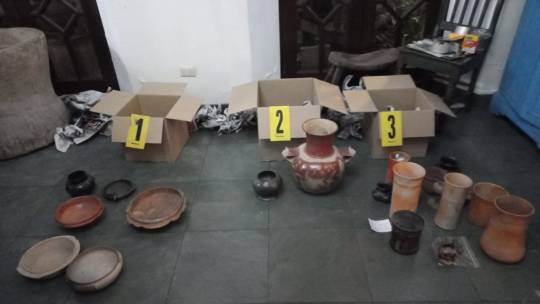
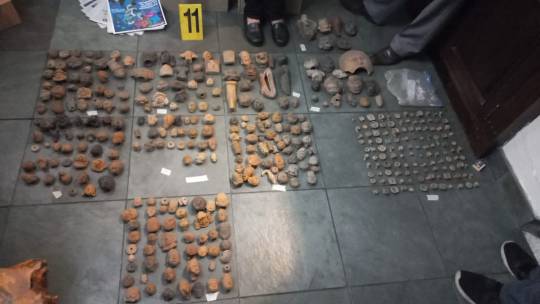
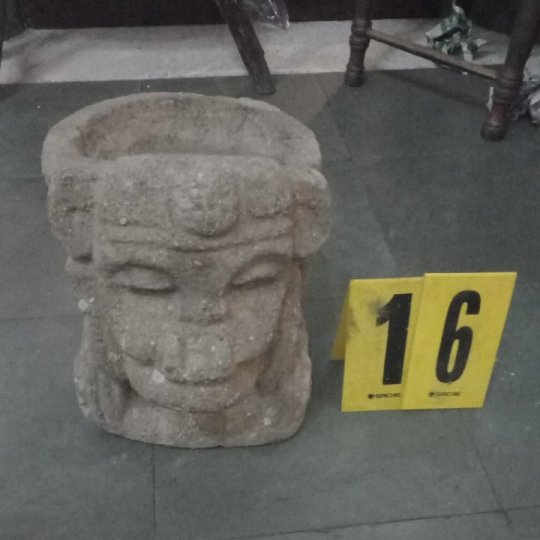

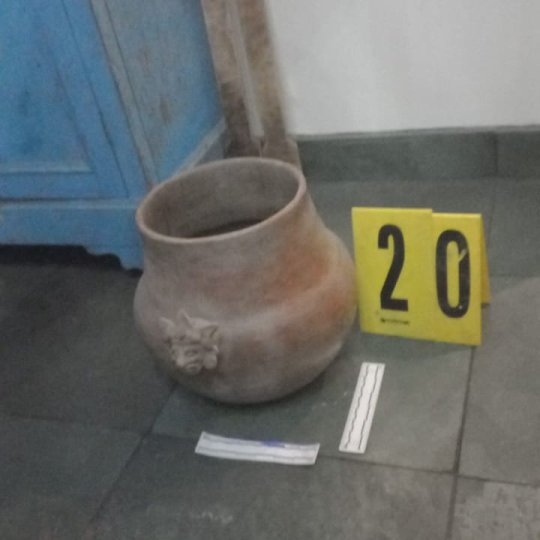
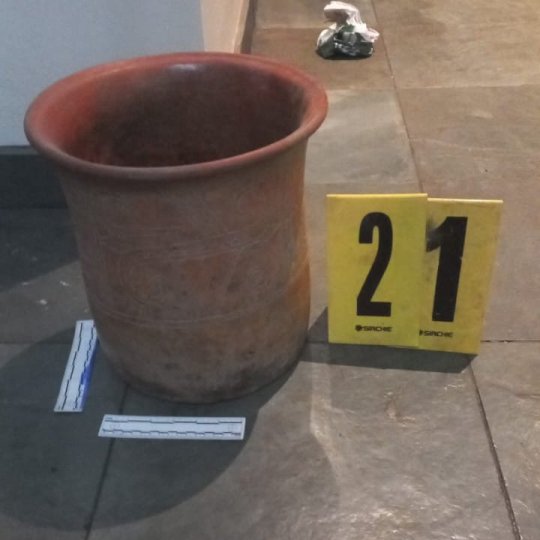

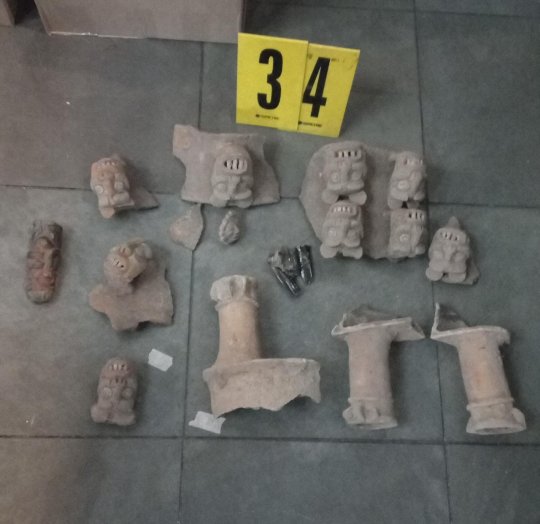
U.S. Citizens Arrested in Guatemala for Smuggling Ancient Mayan Artifacts
A raid of the couple's home uncovered archaeological objects, and significant works in jade and basalt.
An American ex-pat couple in Guatemala is facing charges of smuggling historic artifacts—which could mean five to 10 years in prison if convicted.
Stephanie Allison Jolluck first fell under suspicion on November 10, when she was stopped at Guatemala City airport, the Associated Press reported. Her luggage was quite heavy, triggering an inspection. Inside, officials found two large Maya stone carvings, dating to 600 and 900 C.E. Jolluck claimed to have purchased them at a market in Antigua, where she lives.
It now appears that those sculptures were just the tip of the iceberg. Three days later, police stopped Jolluck in her car, and found 166 more historic artifacts. (A judge had already released her from custody.)
Jolluck was with another American, Giorgio Salvador Rossilli, and both claimed the artworks were worthless reproductions. (Rossilli also claimed that he had restored some of the artifacts found in their car for their owner, and had been returning them when he was arrested.)
“They argued that, because they are foreigners, they cannot tell one piece from another,” prosecutor Jorge Alberto de León told the AP. “They told the judge that because they were pieces of stone they had seen sold at the markets, they never imagined that they were ancient archeological pieces.”
Guatemala’s Culture Ministry begged to differ, finding 90 percent of the objects to be Pre-Hispanic originals. The country believes the couple is operating a network for the illicit trafficking of Maya artifacts and other cultural heritage.
Nonetheless, Judge Sherly Figueroa released Jolluck and Rossilli on $6,400 bail on Monday, prohibiting them from leaving the country and requiring a biweekly check-in with prosecutors.
Then came the raid of their home, conducted by the Office of the Prosecutor for Crimes against the Cultural Heritage of the Nation. The search turned up an astonishing 1,222 archaeological artifacts, 722 significant works in materials such as jade and basalt, as well as 500 smaller pieces.
Other objects seized by the police include computers, books, and a vibrantly colored stuffed bird that may be a quetzal. The General Directorate of Cultural and Natural Heritage of the Ministry of Culture and Sports has taken custody of the artifacts for analysis, according to the nation’s Ministerio Público.
Jolluck, age 49, is a photographer and designer, while the AP described 62-year-old Rossilli as “a connoisseur of Mayan [sic] folk art.” She wrote on her website that she “has always been fascinated by Indigenous cultures. As a lover of ethnographic art, antiques, and handicrafts, I enjoy shopping markets around the world.”
By Sarah Cascone.
#U.S. Citizens Arrested in Guatemala for Smuggling Ancient Mayan Artifacts#looting#smuggling#crime#ancient artifacts#archeology#archeolgst#history#history news#ancient history#ancient culture#maya culture#maya history#mayan artifacts
15 notes
·
View notes
Text
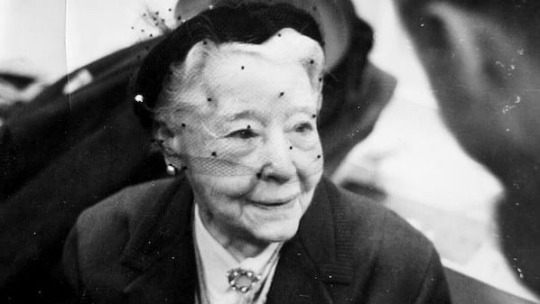






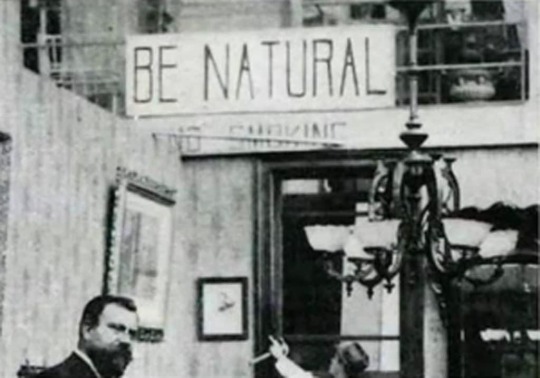
Alice Guy Blaché, 1873 - 1968 - Cinema Pioneer
Alice Ida Antoinette Guy-Blaché was a French #pioneerfilmmaker, active from the late 19th century, and one of the first to make a narrative fiction film.
She was the #firstwoman to direct a film.
From 1896 to 1906, she was probably the only #femalefilmmaker in the world. She experimented with Gaumont's Chronophone sync-sound system, and with color-tinting, interracial casting, and special effects.
She was artistic director and a co-founder of Solax Studios in Flushing, New York. In 1912, Solax invested $100,000 for a new studio in Fort Lee, New Jersey, the center of American filmmaking prior to the establishment of Hollywood.
That year, she made the film A Fool and His Money, probably the first to have an all-African-American cast.
The film is now at the National Center for Film and Video Preservation at the American Film Institute. Via Wikipedia
Born: Alice Ida Antoinette Guy, July 1, 1873, Saint-Mandé, Val-de-Marne, France
Died: March 24, 1968, Wayne, New Jersey, U.S
History’s First Female Filmmaker Has Been Rescued From Obscurity Thanks to an Enlightening New Jodie Foster-Narrated Documentary
Alice Guy-Blaché, the director of nearly 1,000 early films, created what may be the world's first narrative movie. By Sarah Cascone, August 20, 2019
Photo: Alice Guy-Blaché, La Fée aux choux (The Cabbage Fairy)(1900/1896), for Gaumont. Photo courtesy of Musée Gaumont, Paris.
Source: https://news.artnet.com/art-world/alice-guy-blache-pioneering-female-filmmaker-1629004
Watch also:
Be Natural: The Untold Story of Alice Guy-Blaché, directed by Pamela B. Green
https://benaturalthemovie.com/
#BeNatural #GuyBlaché #AliceGuyBlaché #pioneer #femalepioneer #PamelaBGreen #CinemaPioneer
#AliceGuyBlache
#FirstFemaleFilmmaker #JodieFoster #Documentary #herstory #artherstory #retrocinema #OldHollywood #historyofcinema
2 notes
·
View notes
Quote
As her following grew, Qamar was tapped to create works for Indian celebrity chef Floyd Cardoz’s Bombay Bread Bar in New York and the set of The Mindy Project, the television series created by Indian American actor and writer Mindy Kaling. But Qamar still had to stage her own art exhibitions, finding locations and installing works for herself—until she heard from Taittinger. “It was the perfect time. I was at a point of my career where I really just wanted to paint and get that work out,” Qamar said. “This is an industry that’s hard to get into, especially for someone who hadn’t gone to art school and didn’t have any connections in the field. It seemed impossible for me to enter that space.”
Sarah Cascone, 'How Maria Qamar’s Feminist Desi Pop Art Went Viral on Instagram, Charmed Mindy Kaling, and Broke Into the New York Art World, artnet News
#artnet News#Sarah Cascone#Maria Qamar#Floyd Cardoz#Bombay Bread Bar#New York#The Mindy Project#Mindy Kaling#art exhibitions#Richard Taittinger#art industry#art school#connections
5 notes
·
View notes